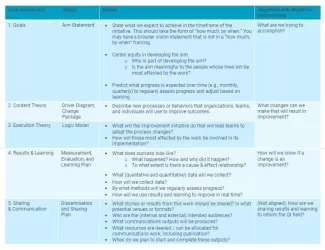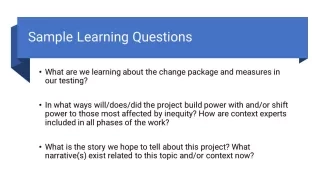Why It Matters

Photo by Thomas Thompson | Unsplash
As a senior project director at the Institute for Healthcare Improvement (IHI), I lead work on the ground every day. I also help to lead IHI’s measurement, evaluation and learning, and dissemination work. I say this to explain that I see things from these different perspectives. In other words, even though I am trained as an evaluation researcher and believe in my bones in the importance of grounding the work of improvement in IHI’s core ideas about design and learning, I understand how easy it can be to get swept up in the day-to-day responsibilities of a project. The many demands on the time and attention of any project team can lead to deprioritizing the foundational efforts that help to anchor the work.
The foundational work I am referring to are the five core components (and the learning questions that accompany them) that help to set improvement work on a path to valuable, reliable, and effective learning throughout the life of the initiative. (See Figure 1.)

Figure 1. IHI Five Core Components that support learning and results
The core components are a framework to design, implement, and continuously learn from improvement work:
- Goals — Those who have participated in improvement initiatives are probably familiar with creating an aim statement. Aim statements bring project goals to life by making clear what we want to accomplish.
- Content Theory — You can think about this as the theory of what. What are the specific changes we believe will lead to achieving the aim? A driver diagram is one way to bring a content theory to life. A driver diagram is a picture of our theory on paper. Theory evolves as we learn.
- Execution Theory — This is the theory of the how. How will we support teams and make it easier for them to test and adopt changes from the content theory? These include coaching calls, learning sessions, action periods, and the partnership supporting improvement teams. The logic model is the tool we recommend to bring the execution theory to life.
We often coach teams — and remind ourselves — to write both the content theory and the execution theory in pencil, not in pen. This can be challenging in a computer age when you’ve got a slide presentation that looks final, but these theories are meant to be revisited throughout the life of the initiative. - Results and Learning — The tool that brings this component to life is a measurement, evaluation, and learning plan that includes both quantitative and qualitative measures. Measurement helps illustrate what we can learn from the data about what happened and why.
- Sharing and Communication — This refers to the dissemination and spread plan. How will we share the results, stories, and learning from our work? As with the other components, this plan is ideally developed at the design stage of an initiative and gets refined as we learn.
The Learning Questions
If you are familiar with research questions or evaluation questions, learning questions are similar. They complement the five Core Components and guide what is most important to know. They are a set of ideally three to five questions that are meaningful to those most affected by the work, implementing the work, and (in some cases) funding the work.
These questions should be specific enough to reflect the efforts of a particular initiative and broad and flexible enough to adapt to what develops. They provide touchstones to guide multiple elements of the work.
Some learning questions may not be reflected in the project’s explicit goals and aims but are still essential to include. For example, there is often an underlying reason an organization, community, or system undertakes a particular project. Maybe there is a new partnership coming together, and an important element of learning might be about what it takes to build a robust collaboration between these entities. If you want to make sure you keep track of what you discover as you go, it is important to note this at the outset.
We have suggested categories of learning questions that can help a project team focus on what they might choose. For example, we recommend having at least one learning question that explicitly focuses on equity.

Why Do Core Components and Learning Questions Matter?
Core components and learning questions center and ground learning. They allow us to be intentional about setting up times and ways to pause and reflect. They compel us to ask important questions: What do we want to learn? What really matters? How might we design our work to get there?
As we start an improvement initiative, we usually have aims and we have maybe one or two pieces of our theory. We may have either a driver diagram or a logic model. Often, we are not yet looking at the big picture. It can be easy to start improvement work without outlining our full measurement strategy. But if we do not lay out our components and learning questions in the beginning, it can be harder to tie the work to our aims or our theories. We can also easily go beyond our original intentions and capacity without a way to verify whether a new idea is within the scope of our initiative. Ultimately, we may decide to adjust the scope or our aims, but it would be ideal to first pause and reflect on how a change builds on our learning, may require additional resources, or compels us to reorder our priorities.
We almost always leave the dissemination and spread strategy to the end. We assume that we know the work we are going to do, and that we will know what we want to share. Yet, we often run out of time or money at the end. Those of us who are eating, breathing, and sleeping the work tend to underestimate what it takes to translate what we understand to others. Also, though we may assume we will remember all the key insights at the end, we often do a better job of capturing important details when we periodically share what we learn throughout the course of a project. We misjudge the effort of distilling what we learned into something — a journal article, blog post, slide set, or report — that may be of use or interest to others.
Core components and learning questions are important anchors for the multiple parties involved in an improvement project. Continuously addressing them allows us to do ongoing knowledge management and to walk the talk of continuous learning and improvement. Doing this is more than just about getting to the aim. It is also about building the capacity of the team and facilitating the work of the improvement teams on the ground, our partners, and even our funders. This helps us build our learning muscles throughout the life of a project.
Marianne McPherson, PhD, is an IHI Senior Director and Improvement Advisor.
You may also be interested in:
